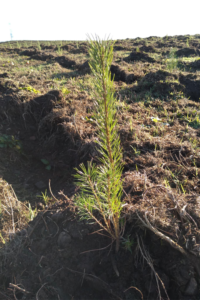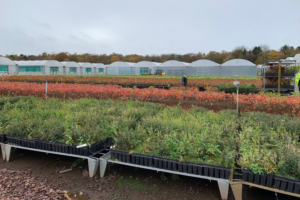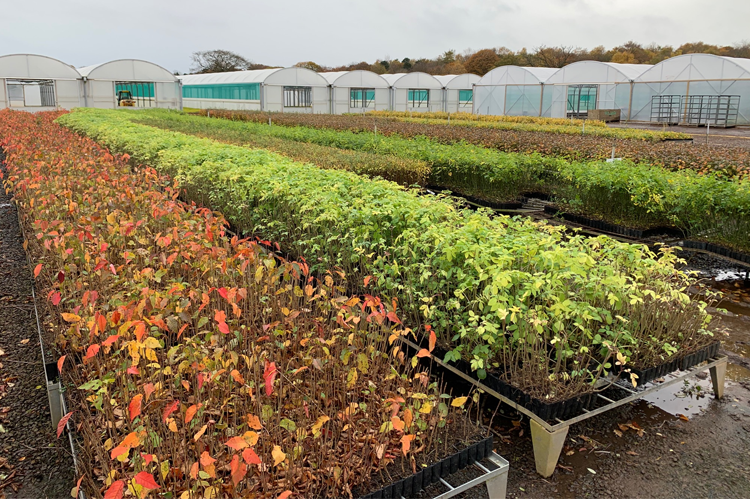The Challenges of Forestry Tree Supply (FWN37 Autumn 2021)
13 December 2021The national focus on tree planting is great news for the forestry sector and forestry nurseries.
The UK is being hugely proactive in encouraging both new woodland creation and new productive forestry to secure timber supplies for the future. In addition, tree planting has been identified as a highly efficient means of carbon capture.
However tree planting ambitions sometimes run way ahead of the reality of how the sector can meet that future demand. Growing trees for forestry takes nurseries between 1 and 3 years – which means an average 3 year time lag between planning for an increased number of trees and the reality of those trees being sent to planting sites.
One of the biggest challenges is seed availability – tree seed has to be collected from established stands, and different species set seed at very different times of the year. There are also huge variations between how much seed is available from year to year, and the viability – which means how many of the seeds will germinate and create good trees.
Species like Oak will traditionally have one very productive season setting seed, followed by a year of very poor collections. There are very few acorns on trees in 2021, for example, and consequently Oak trees will be scarce for the next 2 years. Climate conditions have a major impact – late frosts frequently cause native Cherry seed to drop before fully ripe and long dry spells will often cause trees to drop seed early before it becomes viable.
A further challenge is that seed from some species requires a lengthy treatment process – Juniper can take 3 years to break dormancy, and then a further 3 years to grow. A plan to grow more Juniper would take 6 years to become a reality!
Juniper would take 6 years to become a reality!
Most Conifers are more reliable – they will follow the common good year/bad year pattern, but seed can be stored in good years which generally means consistent availability.
Germination percentages can vary between almost 100%, and as little as 20% – usually affected by the growing season in which the seeds have been set. Nurseries will therefore not know how many trees they will get until relatively far into the production process.
Once seed has been sourced, the biggest challenge for nurseries is labour. Nurseries tend to be in relatively remote locations not close to large centres of population and without a large pool of local resource to draw from, therefore are often reliant on migrant labour – similar to the related agriculture and fruit-picking sectors.
Activity in nurseries has seasonal peaks and troughs, so often requires an input of seasonal labour. However recent changes primarily related to Brexit, but also as a consequence of the pandemic and current labour shortages has meant seasonal and migrant labour in the UK is currently very scarce. Availability of labour is likely to be a significant barrier to increasing tree production – with 2021 being the most challenging year ever in this respect.
Growing trees is a labour intensive process. Larger seeds like Chestnuts, Oak, Sycamore and Cherry require nursery staff to hand sort to identify seeds which are ‘chitting’ (or sprouting). Generally only chitting seeds are sown – if seeds are not chitting, they’re unlikely to grow – which wastes space and resource.
Some species like Aspen and Willow are so small they can only be sown by hand and pricked out from seed trays – in the same fashion that has been happening for decades. This is a very intensive labour process.
Following successful sowing, seedlings have to be transplanted – either into final cells, or into fields for bare root growing. This is another labour intensive process. Trees grow in outdoor locations for up to 2 years – requiring watering, feeding, weeding over that time. They are then finally lifted and ‘graded’ – checked for straightness, girth, good root development and general health – before they are finally ready to be sent to planting sites.
For Alba Trees, there are 5 points in the growing cycle from sowing to despatch where trees get individually handled. This obviously requires a large team of people to be able to produce the trees.
Traditionally, technology has helped to improve efficiencies of production and reduce the reliance on manual labour. Forest nurseries are investigating ways to use new automation to increase production, and believe new technology will be key to increased production. Many nurseries already use seed sowing machines – for species which produce even, regular sized seed. Conifer species are the easiest to sow, but relatively few broadleaf species have seed which can be sown singly and evenly with a sowing machine.
production, and believe new technology will be key to increased production. Many nurseries already use seed sowing machines – for species which produce even, regular sized seed. Conifer species are the easiest to sow, but relatively few broadleaf species have seed which can be sown singly and evenly with a sowing machine.
Seed supply companies are investigating pelletising seed (common in ornamental horticulture), which would be a huge benefit in handling seed from species like Birch and Alder, and produce more and better seedlings.
Alba Trees invested in a transplanting machine this year – these are common across most of horticulture, but not in the forestry sector. Transplanting machines rely on very even germination – with all cells single sown, no weed or moss growth and seedlings sized within a fairly limited range. The transplanting process is massively accelerated using a transplanting machine – and will require far less staff to operate than a hand transplanting line. The challenges for nurseries are increasing the quality of seedlings – which is much harder when the species takes 12-16 weeks from sowing to transplanting, compared to an average 2-3 weeks with ornamental crops.
There has also been technological development and new machinery available for the process of ‘lining out’ trees for bare root growing – speeding up that process.
The changing climate is also a concern – bare root nurseries grow trees in fields with only minimal irrigation – recent extremely hot summers are a risk to crops and an increasing percentage can be lost to drought. Most activity around lifting trees or preparing trees happens in the winter once trees are dormant. Extreme weather events, especially very wet seasons, can majorly disrupt this process.
There are a relatively small number of large format tree nurseries in the UK, all of which have been in the sector for many years – so capacity is relatively constrained. Tree nurseries are experienced and passionate about the sector and willing to invest in their businesses to increase production. Support from UK national governments has helped give nurseries confidence to expand their production – which requires a long-term perspective and deep pockets, given the 2-3 year production cycle.
Greater certainty in future planting plans would also help to give nurseries greater confidence in increasing production – despite very high demand, there are still trees going to waste due to varying timeframes of planting scheme approval.
Whether nurseries can expand production quickly enough to meet rapidly increasing planting targets and political will is debatable due to all the factors involved. However nurseries are passionate about their sector and grateful for public interest and support for increased tree planting. As a sector we are exploring all avenues to try to make more trees available to help meet those ambitions.
Craig Turner, CEO. Alba Trees
This article has been published in the Autumn 2021 edition of the Farm Woodland News. Download a copy to access all articles. Subscribe to receive newly published editions via email by using the form here.
Sign up to the FAS newsletter
Receive updates on news, events and publications from Scotland’s Farm Advisory Service

